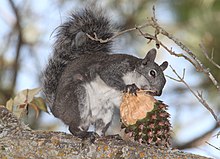Western gray squirrel
| Western gray squirrel | ||||||||||||
|---|---|---|---|---|---|---|---|---|---|---|---|---|

Western gray squirrel ( Sciurus griseus ) |
||||||||||||
| Systematics | ||||||||||||
|
||||||||||||
| Scientific name | ||||||||||||
| Sciurus griseus | ||||||||||||
| Ord , 1818 |
The western gray squirrel ( Sciurus griseus ) is a North American rodent belonging to the squirrel family (Sciuridae). It was first described by George Ord in 1818 , based on notes by Lewis and Clark in The Dalles in Wasco County .
features
The fur of the western gray squirrel is gray in color and has lighter spots in places. It is cream-colored to white on the abdomen, the underside of the head and the insides of the extremities. The outside of the tail can also be colored white. The fur forms a white ring around the eyes.
The western gray squirrel reaches a total body length of 45 to 60 cm (body and tail 25 to 30 cm each) and weighs 350 to 950 grams. This makes it one of the largest species of the squirrel genus ( Sciurus ) and the largest naturally occurring species of this genus on the US west coast.
The ears sit very far back on the skull and have no tufts of hair ( brush ). The ears are only hairy on the outside, which turns reddish brown in winter. There is no dimorphism between the sexes.
Way of life
The western gray squirrel is mostly diurnal. However, it goes to rest at lunchtime when the temperature is high. During the warm seasons, the animals inhabit simple nests made of branches covered with leaves, moss , lichen and pieces of bark. The nests for the young can also be padded with hair from the tail. However, the wintering takes place in fixed nests in tree hollows. These are usually abandoned nests of woodpeckers . The western gray squirrel reduces its activity in the cold season, but does not hibernate .
Western gray squirrels are solitary animals who mostly stay in the branches of tall trees. They step on the ground to switch to another tree if it is too far away from the previous one. The animals can jump up to 2 meters from a standing position.
nutrition
The western gray squirrel is omnivorous . It feeds on nuts , acorns , berries , buds and tree seeds but also on insects , beetles , moths , frogs , bird eggs and birds . In autumn, the animals also eat mushrooms .
The western gray squirrel usually forages in the early morning and evening hours. As a supply for the winter, it stores food reserves in holes in the ground and tree hollows. The western gray squirrel consumes between 43 and 52 grams of food per day, depending on age and gender.
Reproduction
The western gray squirrel reaches sexual maturity at around 10 to 11 months. However, due to rivalries, the males cannot mate with the females until they are two years old.
The mating season begins around the turn of the year. However, in northern regions it can be postponed until June at the latest because of the longer winter. Both sex partners are polygamous . After a gestation period of around 43 to 45 days, the female gives birth to between two and five young. Each weighs about 15 grams. The brood care is done by the female for a good three months. The development of the young is slow compared to other squirrels . They do not separate from their mother until they are three months old and do not leave their nest in the first six weeks of life.
distribution
The western gray squirrel is common in the forests of the western United States ; particularly in California , Oregon , Washington, and far west of Nevada . It can be found both on the plains and in the high mountains up to 2,500 meters.
Ecology and hazard
The western gray squirrel contributes to the balanced growth of the forest due to its high collecting activity of seeds from trees and shrubs. Therefore it is considered to be extremely important for its existence. In the Red List of the IUCN , the Western gray squirrel as "Least Concern" (not endangered) and the Washington Convention not performed because they are still everywhere often found today. In addition, the animals are very adaptable and also feel comfortable around people. In some regions (for example in the national parks in the United States ) they have almost completely shed their shyness. However, a hazard in the foreseeable future cannot be ruled out due to the destruction of the habitat.
Subspecies
There are three subspecies:
- Sciurus griseus griseus - Ord , 1818 (from central Washington to the western Sierra Nevada in central California )
- Sciurus griseus nigripes - Bryant , 1889 (from south of San Francisco Bay to San Luis Obispo County )
- Sciurus griseus anthonyi - Mearns , 1897 (from San Luis Obispo to south-central California)
credentials
- ↑ a b c d e f Sciurus griseus in the Animal Diversity Web
- ↑ Sciurus griseus in the IUCN Red List of Threatened Species 2007
Web links
- Sciurus griseus in the endangered Red List species the IUCN 2006. Posted by: Braillie, J., 1996. Retrieved on October 14 of 2007.
- Sciurus griseus on the Animal Diversity Web
- Washington State Recovery Plan for the Western Gray Squirrel (PDF file; 3.23 MB)
- James Williams: The Biogeography of the Western Gray Squirrel ( Memento from November 12, 2008 in the Internet Archive )

